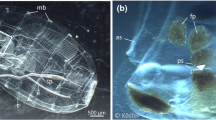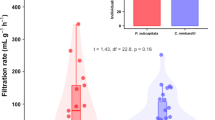Abstract
From July to September 1982 feeding experiments were conducted with 138-mm fork length Atlantic menhaden Brevoortia tyrannus (Latrobe) (Pisces: Clupeidae) to determine their particle size-specific feeding abilities. Monoculture clearing-rate experiments showed that the minimum size of particles filtered, the minimum size threshold, for 138-mm fish is 7 to 9 μm. Filtration efficiency for three species of phytoplankton below the minimum size threshold. Pseudoisochrysis paradoxa, Monochrysis lutheri, and Isochrysis galbana, averaged 1.0% (n=14). Tetraselmis suecica, Prorocentrum minimum, and 2-celled Skeleionema costatum, phytoplankton which are larger than the minimum size threshold and smaller than the 20-μm upper limit for nanoplankton, were filtered at efficiencies averaging 21% (n=24). S. costatum chains of 3 to 6 cells, prey particles exceeding the size limits of nanoplankton, were filtered at average efficiencies ranging from 22 to 84%. The mean filtration efficiency for Artemia sp. nauplii (San Francisco Bay Brand) of 36% (n=7) was lower than for smaller phytoplankton prey. The presence of detritus at concentrations usually encountered in nature enhanced filtering efficiency and lowered minimum size thresholds at which phytoplankton were retained. For small food particles, filtering efficiency decreased as swimming speed of the menhaden increased. As menhaden grow, their feeding tepertoire shifts to larger planktonic organisms.
Similar content being viewed by others
Literature cited
Avninelech, T., B. W. Troegur and L. W. Reed: Mutual flocculation of algae and clay: evidence and implications. Science, N.Y. 216, 63–65 (1982)
Blaxter, J. H. S. and J. R. Hunter: The biology of the clupeoid fishes. Adv. mar. Biol. 20, 1–223 (1982)
Chipman, W. C.: The use of radioisotopes in studies of the foods and feeding activities of marine animals. Pubbl. Stn. Zool. Napoli (Suppl.) 31, 154–174 (1959)
Darnell, R. M.: Food habits of fishes and larger invertebrates of Lake Pontchartrain, Louisiana, an estuarine community. Publ. Inst. mar. Sci. Univ. Tex. 5, 353–416 (1958)
Drenner, R. W., J. R. Strickler and W. J. O'Brien: Capture probability: the role of zooplankton escape in the selective feeding of planktivorous fish. J. Fish. Res. Bd Can. 35, 1370–1373 (1978)
Dryfoos, R. L., R. P. Cheek and R. L. Kroger: Preliminary analyses of Atlantic menhaden, Brevoortia tyrannus, migrations, population structure, survival and exploitation rates, and availability as indicated from tag returns. Fish. Bull., U.S. 71, 719–734 (1973)
Dupuy, J. L., N. J. Windsor and C. E. Sutton: Manual for design and operation of an oyster seed hatchery. Spec. Rep. Appl. Mar. Ocean Eng. Va. Inst. Mar. Sci. 142, 1–104 (1977)
Durbin, A. G.: Food selection by plankton feeding fishes. In: Predatory-prey systems in fisheries management, pp 203–218. Ed. by H. Clepper. Washington, D.C.: Sport Fishing Institute 1979
Durbin, A. G. and E. G. Durbin: Grazing rates of the Atlantic menhaden Brevoortia tyrannus as a function of particle size and concentration. Mar. Biol. 33, 265–277 (1975)
Durbin, E. G. and A. G. Durbin: Assimilation efficiency and nitrogen excretion of a filter-feeding planktivore, the Atlantic menhaden Brevoortia tyrannus (Pisces: Clupeidae). Fish. Bull., U.S. 79, 601–616 (1981)
Durbin, E. G., R. W. Krawiec and T. J. Smayda: Seasonal studies on the relative importance of different size fractions of phytoplankton in Narragansett Bay (USA). Mar. Biol. 32, 271–287 (1975)
Durbin, A. G., E. G. Durbin, P. G. Verity and T. J. Smayda: Voluntary swimming speed and respiration rates of a filter-feeding planktivore, the Atlantic menhaden, Brevoortia tyrannus (Pisces: Clupeidae). Fish. Bull., U.S. 78, 877–886 (1981)
Gerber, R. P. and N. Marshall: Ingestion of detritus by the lagoon pelagic community of Eniwetok Atoll. Limnol. Oceanogr. 19, 815–824 (1974)
Gifford, D. J., R. N. Bohrer and C. M. Boyd: Spines on diatoms: do copepods care? Limnol. Oceanogr. 26, 1057–1061 (1981)
Haas, L. W.: Improved epifluorescent microscopic technique for observing planktonic micro-organisms. Ann. Inst. Oceanogr. 58, 261–266 (1982)
Harvey, W. H.: Note on selective feeding by Calanus. J. mar. biol. Ass. U.K. 22, 97–100 (1937)
Hawkin, A. D. and P. D. Anthony: Aquarium design and construction. In: Aquarium systems, pp 1–47. Ed. by A. D. Hawkin. New York: Academic Press 1981
Jefferies, H. P.: Diets of juvenile Atlantic menhaden in three estuarine habitats as determined from fatty acid composition of gut contents. J. Fish. Res. Bd Can. 32, 587–592 (1975)
June, F. C. and F. T. Carlson: Food of young Atlantic menhaden, Brevoortia tyrannus, in relation to metamorphosis, U.S. Fish Wildl. Serv. Fish. Bull. 68, 493–512 (1971)
Kremer, J. N. and S. W. Nixon: A coastal marine ecosystem, 217 pp. New York: Springer-Verlag 1978
Magnuson, J. J. and J. G. Heitz: Gili raker apparatus and food selectivity among mackerels, tunas, and dolphins. Fish. Bull., U.S. 69, 361–370 (1971)
Malone, T. C.: Light-saturated photosynthesis by phytoplankton size fractions in the New York Bight, USA. Mar. Biol. 42, 281–292 (1977)
Malone, T. C., M. B. Chervin and D. C. Boardman: Effects of 22 μm screens on size frequency distributions of suspended particles and biomass estimates of phytoplankton size fractions. Limnol. Oceanogr. 24, 956–960 (1979)
McCarthy, J. J., W. R. Taylor and M. E. Loftus: Significance of nanoplankton in the Chesapeake Bay Estuary and problems associated with the measurement of nanoplankton productivity. Mar. Biol. 24, 7–16 (1974)
McHugh, J. L.: Estuarine nekton. In: Estuaries, pp 581–620. Ed. by G. H. Lauff. Washington, D. C.: American Association for the Advancement of Science 1967
Nicholson, W. R.: Movements and population structure of Atlantic menhaden indicated by tag returns. Estuaries 1, 141–150 (1978)
Oviatt, C. A., A. L. Gall and S. W. Nixon: Environmental effects of Atlantic menhaden on surrounding waters. Chesapeake Sci. 13, 321–323 (1972)
Peck, J. I.: On the food of the menhaden. Bull. U.S. Fish. Comm. 13, 113–126 (1893)
Peters, D. S.: Feeding selectivity in juvenile Atlantic menhaden, Brevoortia tyrannus (Pisces: Clupeidae). (Abstract). ASB (Ass. Southeast. Biol.) Bull. 19, 91 (1972)
Peters, D. S. and M. A. Kjelson: Composition and utilization of food by various postlarval and juvenile fishes of North Carolina estuaries. In: Estuarine research, vol. 1, pp 447–472. Ed. L. E. Cronin. New York: Academic Press 1975
Peters, D. S. and W. E. Schaaf. Food requirements and sources for juvenile Atlantic menhaden. Trans. Am. Fish. Soc. 110, 317–324 (1981)
Porter, K. G., Y. S. Feig and E. F. Vetter: Morphology, flow regimes, and filtering rates of Daphnia, Ceriodaphnia, and Bosmina fed natural bacteria. Oecologia 58, 156–163 (1983)
Reintjes, J. W. and A. L. Pacheco: The relation of menhaden to estuaries. Am. Fish. Soc. Spec. Pub. No. 3, pp 50–58 (1966)
Rice, D. L.: The detritus nitrogen problem: new observations and perspectives from organic geochemistry. Mar. Ecol. Prog. Ser. 9, 153–162 (1982)
Richards, S.: The demersal fish population of Long Island Sound. Bull. Bingham oceanogr. Collect. Yale Univ. 18, 5–101 (1963)
Runge, J. A. and M. D. Ohman: Size fractionation of phytoplankton as an estimate of food available to herbivores. Limnol. Oceanogr. 27, 570–576 (1982)
Sheldon, R. W. and W. H. Sutcliffe: Retention of marine particles by screens and filters. Limnol. Oceanogr. 14, 441–444 (1969)
Sieburth, J. M., V. Smetacek and J. Lenz: Pelagic ecosystem structure: heterotrophic compartments of the plankton and their relationship to plankton size fractions. Limnol. Oceanogr. 23, 1256–1263 (1978)
Singarajah, K. V.: Escape reactions of zooplankton: the avoidance of a pursuing siphon tube. J. exp. mar. Biol. Ecol. 3, 171–178 (1969)
Tenore, K. R.: What controls the availability to animals of detritus derived from vascular plants: organic nitrogen enrichment of caloric availability? Mar. Ecol. Prog. Ser. 10, 307–309 (1983)
Van Valkenburg, S. D., J. K. Jones and D. R. Heinle: A comparison by size and class and volume of detritus versus phytoplankton in Chesapeake Bay. Estuar. cstl mar. Sci. 6, 569–582 (1978)
Author information
Authors and Affiliations
Additional information
Communicated by J. M. Lawrence, Tampa
Contribution No. 1201 Virginia Institute of Marine Science
Rights and permissions
About this article
Cite this article
Friedland, K.D., Haas, L.W. & Merriner, J.V. Filtering rates of the juvenile Atlantic menhaden Brevoortia tyrannus (Pisces: Clupeidae), with consideration of the effects of detritus and swimming speed. Mar. Biol. 84, 109–117 (1984). https://doi.org/10.1007/BF00392994
Accepted:
Issue Date:
DOI: https://doi.org/10.1007/BF00392994




